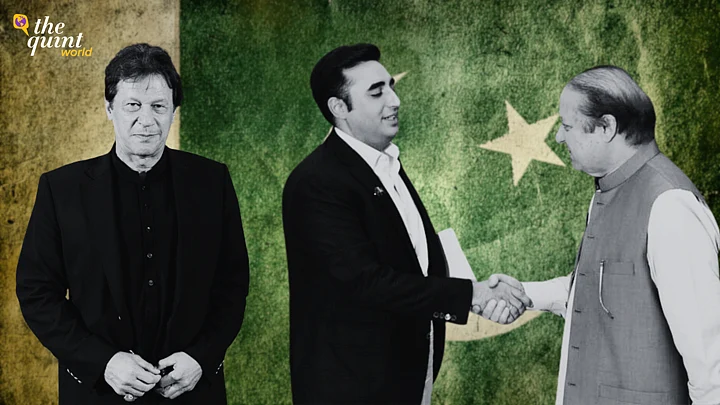Expectations are that the general elections in Pakistan would calm its turbulent politics and enable the country to overcome what is called its “polycrisis” involving the economy, terrorism, and its dysfunctional politics.
For this, Pakistan needed a stable government that had the strong support of the people, but the outcome suggests that it will be anything but that.
All of that, however, could have happened had the all-powerful military let the Election Commission allow candidates to campaign freely and conduct a transparent count of the ballots. But it did not.
Former Prime Minister Imran Khan has, nevertheless, delivered a stellar performance. With the whole election system systematically stacked against him and his party, the Pakistan Tehreek-e-Insaf (PTI), he has shown us how to fight and stay the winner.
Nawaz and Imran Both Claimed Victory
According to unofficial results at the time of writing, for 250 out of 266 seats in the National Assembly, independent candidates put up by the PTI are leading with 91 seats, the Pakistan Muslim League (Nawaz) is trailing with 71 seats, and Bilawal Bhutto’s Pakistan People’s Party (PPP) has 54 seats.
Elections were held for 265 seats, and a party needs 133 seats for a simple majority.
In the provincial assemblies, the PML(N) has a narrow lead over the PTI. In Sindh, the PPP has swept the election, and its the same in Khyber Pakhtunkhwa. In Balochistan, no party has done well, except some non-PTI independents. In Tharparkar, Sindh, the PPP’s Mahesh Kumar Malani secured an easy win, making history as the first non-Muslim to win a general seat in the National Assembly.
Saturday, 10 February, saw Nawaz Sharif and Imran Khan both claiming victory. Nawaz’s position was that he represented the largest single party. The PTI was not allowed to contest as a party and technically, all its legislators are independents.
Incidentally, Nawaz lost the Mansehra seat to Shahzada Khan, a PTI independent, but he managed to win the Lahore seat, defeating another independent Yasmin Rashid. Another significant loser was JUI [Jamiat Ulema-e-Islam (F)] chief Maulana Fazlur Rehman, an old Khyber Pakhtunkhwa warhorse, who lost to a PTI-backed independent.
As for Imran, who defied a months-long crackdown that saw him in jail and convicted on three separate charges, he “spoke” through his AI-enabled voice claiming victory. He also declared that the “London Plan” to bring back PML(N) chief Nawaz Sharif to take over the government had failed with a massive turnout on polling day that pushed the independents to victory. Even while claiming his supporters had won 170 seats, he charged the election commission with malfeasance and rigging.
For the record, the man whose organisation was supposed to guarantee Nawaz’s victory — Pakistan Army Chief General Asim Munir — congratulated the nation on the successful conduct of the elections. He thanked the election machinery, the media, civil society, and the judiciary, but had little to say about the outcome.
In the coming days, there will be a lot of wheeling and dealing, and questions about who the winner is. For example, can the independents with the biggest share of seats elect an “independent PM”?
PML(N) and PPP Coalition Seems Like the Obvious Route
There is little doubt that the PTI performance is a setback to the Pakistan military, which did everything it could to back Nawaz and keep out Imran and the PTI. Its stand in the coming days is likely to be shaped by General Munir’s statement on Saturday morning that “the nation needed stable hands and a healing touch to move on from the politics of anarchy and polarisation which does not suit a progressive country of 250 million people.”
The most obvious route to that goal would be a coalition of the PML(N) and the PPP, along with some independents, and form the governments at the Centre and Punjab. However, such a government will be handicapped by the lack of legitimacy in the eyes of the people and is not likely to be able to provide the stability that Pakistan so desperately needs.
On Friday, 9 February, even as the results trend was apparent, Nawaz Sharif said that he had asked his brother, former PM Shehbaz Sharif, to reach out to major parties like the PPP and the MQM(P) to form a coalition.
Shehbaz met PPP leader Asif Ali Zardari and his son Bilawal Bhutto-Zardari in Lahore. He later had discussions with the MQM-P convenor Dr Khalid Maqbool Siddiqi, by phone and the two said that they would meet personally soon. The MQM(P), the party of Muhajirs who migrated from India, is strong in Karachi.
The PPP and the PML(N) had been part of a coalition that had succeeded the PTI government after its ouster in 2022. An option that is being spoken of for the PTI-independents is that they merge themselves with the Majlis-e-Wahdat-ul-Muslimeen (MWM), who are long-standing allies of the PTI.
(The writer is a Distinguished Fellow, Observer Research Foundation, New Delhi. This is an opinion piece and the views expressed above are the author’s own. The Quint neither endorses nor is responsible for the same.)
